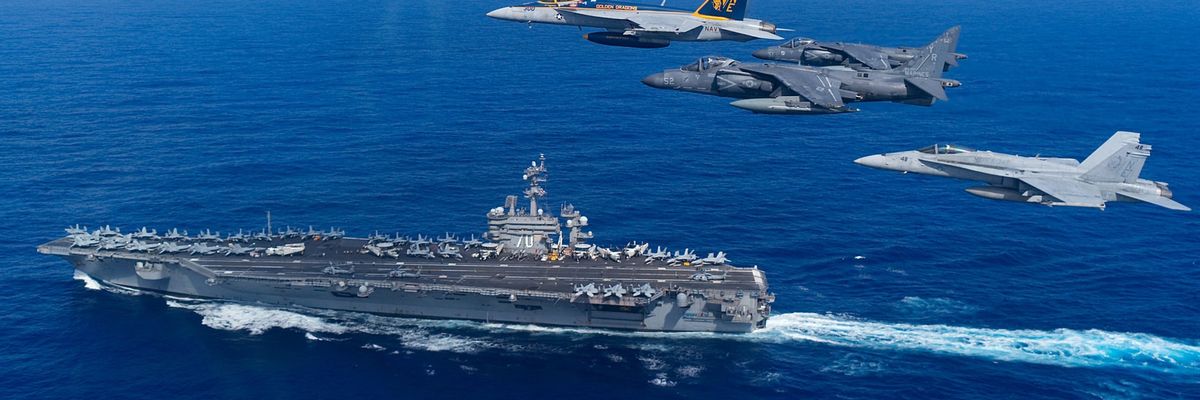North Korea continues to test missiles, unsettling its neighbors and thwarting U.S. policy. In early October Pyongyang shot off two short-range missiles, triggering a United Nations Security Council debate.
The Democratic People’s Republic of Korea’s testing program appears to have taken an ominous turn. Nikkei Asia’s Junnosuke Kobara explained: “Kim Jong-un's regime is spotlighting missiles that have reached mass production, rather than showing off its technological developments for new weapons.”
By showcasing its warfighting capabilities Pyongyang is enhancing deterrence, reinforcing the military case against Washington attempting a preventative strike against North Korea’s nuclear assets. Explained Pyongyang: “The missile test launch by the DPRK is a regular and planned self-defensive step for defending the country’s security and the regional peace from the U.S. direct military threats that have lasted for more than half a century.”
Indeed, Pyongyang is mimicking the United States. Washington recently deployed the U.S.S. Ronald Reagan to Northeast Asia. Indo-Pacific Command issued a statement on the carrier’s arrival to reassure Washington’s security dependents: “The U.S. commitments to the defense of the Republic of Korea and Japan remain ironclad.”
Reported the New York Post: “A U.S. aircraft carrier arrived in South Korea on Friday for the first time in about four years, set to join other military vessels in a show of force intended to send a message to North Korea, officials said.”
It’s a familiar U.S. tactic. Nor are aircraft carriers Washington’s only messenger. In 2017 Trump sent two B-1 bombers over South Korea, with a focus on the North.
With or without such deployments, it is likely that not a day has gone by without Kim thinking about the destructive power of the U.S. military. In fact, that is the best explanation for North Korea’s missile and nuclear developments. The North’s continuing tests remind potentially forgetful allied officials that the DPRK has scores of nukes and even more missiles, with increasing range.
North Korea is not the only target of U.S. messaging. In early September the Biden administration deployed two B-52s to the Middle East. Nuclear-capable B-52s, the military emphasized. “Threats to the U.S. and our partners will not go unanswered,” announced Lt. Gen. Alexus Grynkewich: “Missions like this ... showcase our ability to combine forces to deter and, if necessary, defeat our adversaries.”
By which he meant Iran.
Washington appears to believe that the Iranian leadership is even more forgetful than North Korea’s. The Pentagon staged a similar flyover in June. A year ago the Biden administration used a different plane as its messenger. Reported the Associated Press: “The U.S. Air Force said Sunday it flew a B-1B strategic bomber over key maritime chokepoints in the Mideast with allies including Israel amid ongoing tensions with Iran as its nuclear deal with world powers remains in tatters.”
In January 2021 Washington staged another two-B-52 fly-by. Explained CNN: “The U.S. military flew two B-52 bombers to the Middle East … from their base in the United States—the fourth such deployment and show of force by the U.S. Air Force aimed at sending a message to Iran in the past two months.”
Also well-publicized are regional visits by American aircraft carriers. The U.S.S Nimitz was deployed in April 2020, succeeding the U.S.S Abraham Lincoln, sent the previous May. In Spring 2020 the U.S. Navy had two carriers on station. Gen. Frank McKenzie, head of Central Command, said he “would caution Iran and its proxies from attempting a response that would endanger U.S. and coalition forces or our partners.”
Alas, there is no evidence that the intended targets of these military messages are intimidated by ritualistic shows of force. Even some hawkish analysts scorn this approach. Kathryn Wheelbarger and Dustin Walker, who served in the executive and legislative branches, respectively, observed: “Sending the most advanced and expensive U.S. conventional forces to the Middle East in response to every potential provocation isn’t an effective or sustainable way to deter Iran’s bad behavior. Continuing this approach wastes taxpayer dollars, drains military readiness, and deprives the U.S. of ready forces needed to compete with and deter China and Russia.”
David B. Larter of Defense News raised similar concerns: “there’s ample evidence that the deployment draws forces away from operations aimed at deterring China and Russia — something on which the U.S. is supposed to focus per its National Defense Strategy. Furthermore, [analysts] told Defense News that the payoff for maintaining two carriers in the region may not be worth the stinging toll it exacts on Navy readiness, adding that pursuing such as strategy will reverse the hard-won readiness gains of recent years.”
One sign of futility is the fact that these operations never result in military action. Of course, that could mean perfect deterrence. However, that seems unlikely. At least, if deterrence was perfect, it would not be necessary to keep sending ships and planes, again and again. More seriously, Tehran’s and Pyongyang’s activities, manifold, disruptive, and threatening from the standpoint of Washington and its allies, showed no evidence of ebbing.
Of course, it is difficult to prove a negative. However, North Korea remains a human rights horror, continues to bluster against its neighbors, and refuses to talk with Washington, all the while developing nuclear weapons and expanding its missile arsenal. Things could be worse, in theory, but Pyongyang does not appear to be much inhibited.
Similarly, Iran’s demonstrated little evidence of effective deterrence. Although Trump and Secretary of State Mike Pompeo play-acted as tough guys vis-à-vis Iran, they did little in response to increased nuclear activity and attacks on the U.S. embassy in Iraq and Saudi oil facilities, disruption of Gulf oil transit, and other provocations at the time.
There is another, perhaps even greater problem. The higher the profile of U.S. military forays into the Middle East or Asia, the more Washington appears to be taking responsibility for security in those regions. Multiple administrations have said they want allies to do more. However, why should America’s defense dependents act when the U.S. avidly carries the burden? Alas, Americans’ actions send a message to friends as well as adversaries, and not a positive one in this case.
Deploying U.S. planes and ships has become Washington’s go to policy to demonstrate resolve. In fact, these deployments are wasteful and likely to undermine American security. It is time for U.S. administrations to change course and choose substance over symbolism.

















